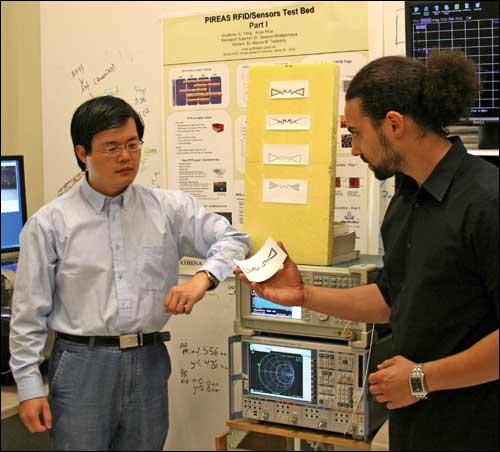Ever since the discovery of carbon nanotubes in 1991, scientists have been exploring ways to exploit the unique electrical properties of these tiny yet strong carbon molecules. But there have been few commercial applications, mainly because of the high production costs associated with harnessing their capabilities.
Enter researchers at the Georgia Institute of Technology‘s Georgia Electronic Design Center (GEDC), who were on a quest to create a batteryless RFID tag that could monitor air quality and detect gases. Since nanotubes have the ability to sniff out the tiniest traces of ammonia, nitrogen oxide and other deadly gases, they decided to pair a carbon nanotube with an RFID antenna. The result? A passive RFID sensor node that has the potential to save lives. The GEDC researchers say they’ve circumvented the high cost of developing a commercial application, because they don’t need to purify the nanotubes, which is often required.

They’ve overcome another limitation as well. When a carbon nanotube detects a gas, its electrical conductivity (in effect, a radio frequency signal) changes. If the change can create a strong enough signal, that signal can be transmitted via an RFID antenna to a nearby interrogator. But most carbon nanotubes have been able to produce signal frequencies of only about 10 MHz, says Li Yang, a GEDC graduate research assistant working on the project. “At that low frequency, it’s very hard to find applications,” he says. “We’ve developed a recipe of the carbon nanotube that can operate at 1 GHz, and that means it could be used in the UHF band.”
The research team has developed a prototype tag—an integrated RFID antenna and carbon nanotube composite printed on a paper substrate, operating at 868 MHz. “There are chemical sensors available, but all of them require battery supply, and they are very bulky,” Yang says. To monitor air quality, the wireless gas-sensor node could be affixed to a soldier’s helmet or to a wall in a chemical plant. Fixed or handheld RFID readers “could monitor any backscatter energy changes that would indicate toxic gases or a gas leakage,” he says.
The team, which includes Amin Rida, a graduate research assistant, and Emmanouil Tentzeris, a professor and leader of the GEDC’s RFID activities, is working with Georgia Tech Research Corp.‘s Office of Technology Licensing to identify partners to develop commercial products based on the new technology. You can read more about their research in the April edition of IEEE Antennas and Wireless Propagation Letters, and in their soon-to-be-published book, RFID and RFID-Enabled Sensors on Flexible Low-Cost Substrates (Morgan & Claypool Publishers).

